1. INTRODUCTION
According to the Intergovernmental Panel on Climate Change (IPCC), it is critical to retain forest carbon storage and to constantly produce wood, fiber, and energy from forests as annual yields in order to maximize the impact of a long-term sustainable forest management plan (IPCC, 2007). When compared to functionally similar petroleum or mineral resources, wood products often have lesser environmental implications (Lippke et al., 2011; Werner and Richter, 2007; Werner et al., 2005). In particular, from the cascading viewpoint, wood may be exploited step by step from basic material to numerous uses. Because wood is eventually used as fuel, it provides environmental benefits over other materials (European Commission, 2011). Timber supplies were destroyed in Korea during the Japanese colonial era and the Korean War (Hur, 2005), but reforestation was effectively carried out owing to the adoption of a robust system and economic growth that reduced dependence on forests (Lee et al., 2017). As a result, the growing stock per hectare increased from 5.7 m3/ha in 1953 to 165.2 m3/ha in 2020. However, as of 2009, the growing stock of age classes IV and V grew significantly, whereas the growing stock of age classes II and III fell progressively, resulting in forest aging. The rate of greenhouse gas absorption in the forest sector has progressively declined from 12.4% in 2000 to 8.9% in 2010 and 6.4% in 2017 (KFS, 2020). As a result, one of the challenges to deal with the climate problem is to create and maintain forests, which are carbon sinks, and to expand the usage of wood, which is a carbon storage.
To revitalize wood utilization, Korea Forest Service (KFS) established the Act on the Sustainable Use of Timbers (KFS, 2013), and is developing various policies and laying a social framework for wood utilization and wood culture promotion. The public’s perception of wood and wood culture, on the other hand, is restricted to cultural assets such as hanok, furniture, and crafts or wood products. Furthermore, there are mutually conflicting ideas that the usage of wood has a positive impact on the environment by increasing the carbon storage effect and that it is deforestation via logging (Han and Lee, 2021a). Wood culture resources are tangible and intangible products created by human cultural activities that include the cultural worth of wood or wood utilization in terms of conservation, discovery, and utilization (Han et al., 2021). Due to a lack of understanding about wood cultural resources, the general public’s degree of engagement is low, despite a reasonably high desire to utilize it (Han and Lee, 2021b).
Recently, as the public’s interest in eco-friendliness and health has grown owing to improved living standards. As a result, awareness of wood as a natural material has improved and the ratio of selecting wood as a material for residence and living has risen. Consequently, studies are being conducted to quantify the beneficial impacts of utilizing wood as a building material on the human body and the environment. According to one study, the sense of seeing or touching wood modifies the human physiological index (Ikei et al., 2017). Furthermore, it was found that wood installed indoors lowered stress (Burnard and Kutnar, 2015), enhanced sleep quality, and made individuals feel more comfortable (Morita et al., 2020). In Korea, researchers investigated effects of essential oils extracted from wood against inflammations (Yang et al., 2019), bacteria (Ham et al., 2020), and skin and lung diseases (Ahn et al., 2018, 2021).
A survey was undertaken in this research to evaluate the present state and needs linked to wood cultural experience of the general public, with the objective of boosting the social and educational value of wood. The survey questions were classified into seven categories: (1) Awareness of wood culture, (2) use characteristics of wood, (3) preference and demand for wood culture, (4) awareness for wood culture sub-field, (5) awareness for wood cultural resources, (6) trend of wood utilization, and (7) wood-related living environment. The survey was conducted in such a way that the respondents were asked questions about the details of each survey item. The survey results were analyzed in four parts: “Awareness of wood and cultural experience” (Han and Lee, 2021a), “Awareness of wood cultural resources by type” (Han and Lee, 2021b), “living environment and the trend of wood utilization”, and “preference and demand for wood culture”. Based on the survey results, this study analyzed the public’s living environment and the trend of wood utilization.
2. MATERIALS and METHODS
From October 20 to October 29, 2020, an online web panel polled 2,500 general individuals over the age of 19 in Korea on the present state and needs for wood cultural experience. When compared to conventional surveys such as phone surveys and in-person surveys, online web panel surveys save time and money. Furthermore, it may be set in various designs and formats, and survey respondents’ replies can be reviewed quickly (Ryu and Moon, 2014). However, the online web panel survey has a problem in that a representativeness error arises, which indicates that the target population and the sample frame are inconsistent (Gim and Kim, 2004). To address the limitations of this online web panel survey, the sample was collected based on the composition ratio of the population by gender and age in 17 Korean metropolitan cities and provinces using proportional allocation based on the composition ratio of the population by gender and age in Korea. The information about the subjects of survey is the same as in earlier research (Han and Lee, 2021a, 2021b), and respondent information by gender, age, educational background, family income, and regional classification is shown in Table 1.
The main contents of the survey on the current status and requirements associated with wood culture experience consist of seven items: Awareness of wood culture, use characteristics of wood, preference and demand for wood culture, awareness for wood culture, awareness for wood cultural resources, trend of wood utilization, and wood- related living environment. The details of these seven items are presented in Table 2. The present study analyzed the survey results for some of the fourth item “awareness for wood culture sub-field”, the sixth item “trend of wood utilization”, and the seventh item “wood-related living environment”. The survey items analyzed in this study are indicated by bold font in Table 2. The questionnaire used in this survey can be found in an appendix of the previous study (Han and Lee, 2021a).
A survey of 18 people, including experts from associations and organizations related to wood and wood products, and university professors in the field of wood utilization, was conducted to analyze the difference in awareness between the general public and experts about the trend of wood utilization presented in Table 2. Text mining was also performed on search results for “wood” in Google, Naver, and Daum portal sites using Textom (IMC, Daejeon, Korea), a big data analysis and collection tool. From September 2017 to August 2020, these three main portal sites gathered 19,991 pieces of information (Table 3). UCINET, a web-based statistical analysis application (Analytic Technologies, Lexington, KY, USA), was used to analyze the gathered data.
| Channel | Section | Number of data collected |
|---|---|---|
| Naver | Blog (https://section.blog.naver.com/) | 3,000 |
| News (https://news.naver.com/) | 2,586 | |
| Cafe (https://section.cafe.naver.com/ca-fe/) | 3,000 | |
| Knowledge iN1) (https://kin.naver.com/) | 3,000 | |
| Subtotal | 11,586 | |
| Daum | Blog (https://blog.daum.net/) | 2,578 |
| News (https://news.daum.net/) | 2,199 | |
| Cafe (https://top.cafe.daum.net/) | 2,893 | |
| Subtotal | 7,670 | |
| News (https://news.google.com/) | 735 | |
| Total | 19,991 | |
3. RESULTS and DISCUSSION
The general public replied to the idea that wood utilization will rise in the future with a positive rate of 79.3% and a negative rate of 20.7%. Females (81.3%) had a higher positive rate than men (77.3%). According to the age of the respondents, the proportion of positives was 70.7% for those aged 29 and under, 74.3% for those in their 30s, 80.9% for those in their 40s, 84.3% for those in their 50s, and 84.1% for those aged 60 and over. Thus, the positive rate increased with age.
“Counterplan for environmental issues such as climate change” (34.5%) and “positive influence on the body and emotional aspects” (30.0%) were mainly suggested as reasons for thinking that wood utilization would increase [Fig. 1(a)]. In addition, various opinions regarding the reason for thinking that wood utilization would not increase were presented, such as utilization for multipurpose, and visual beauty were presented. On the other hand, “high price” (28.2%), “difficult to manage” (23.4%), “incompatible with smart modern society” (18.3%), and “environmental impact of cutting” (17.4%) and “hazardous chemical treatment” [11.6%; Fig. 1(b)]. In the figure, N denotes the number of respondents.
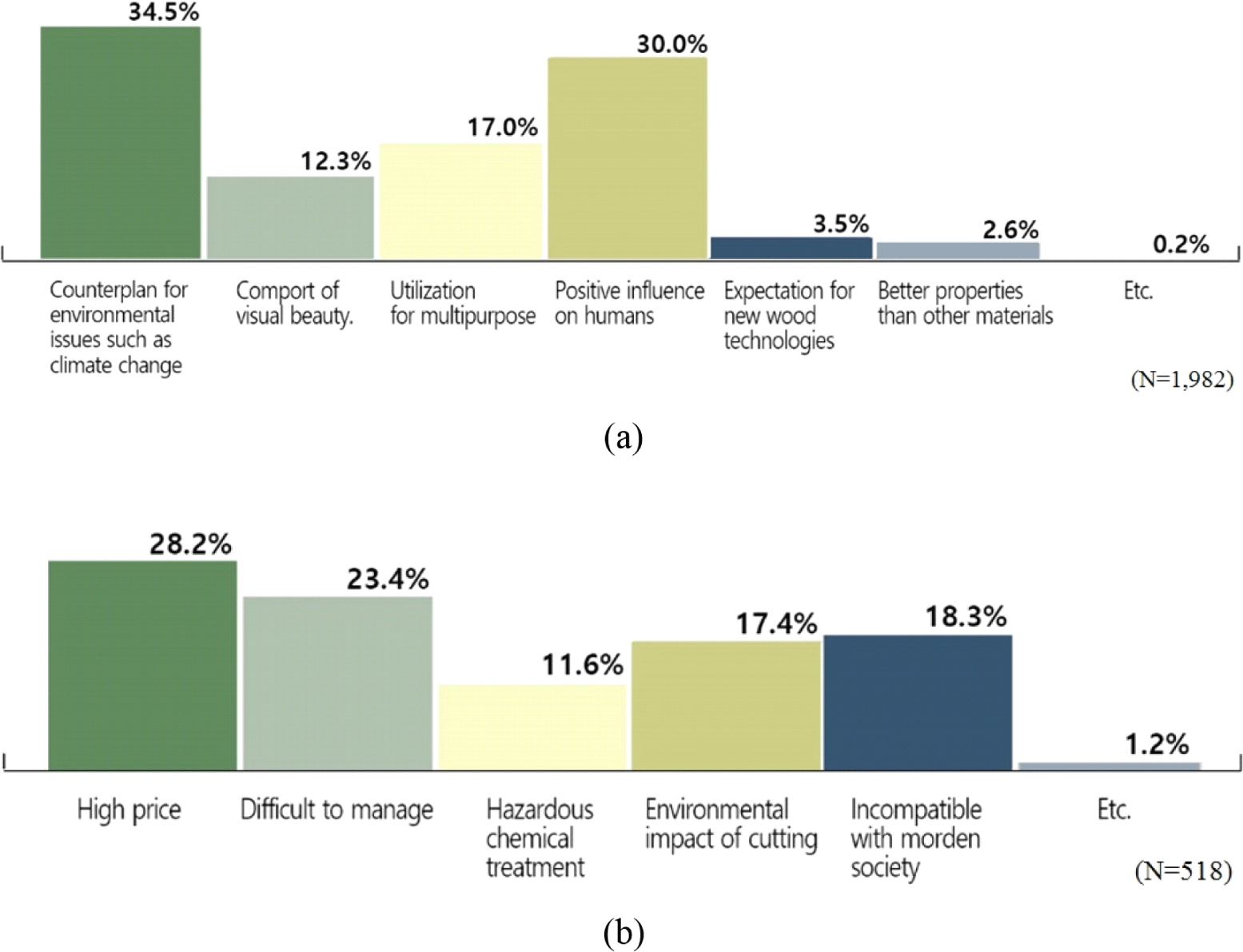
While some believed that wood utilization will rise as a means of addressing environmental issues such as climate change, others believed that wood utilization will not increase because logging for wood production causes environmental problems. These findings are consistent with the survey findings on the associated image of “wood” and the perception of “wood utilization” (Han and Lee, 2021a). Concerning negative reactions to wood, such as “logging” and “expensive,” it is vital to shift public opinion via publicity that wood functions as a carbon storage and is a sustainable recycling resource (Lippke et al., 2011). Furthermore, for negative perceptions of wood utilization such as “old material,” “difficulty in management,” and “chemical treatment,” publicity is required to improve negative perceptions by utilizing research results such as strengthening the effect of preservative treatment of wood products (Cahyono et al., 2020; Lee et al., 2020; Priadi et al., 2020) and toxicity analysis of chemicals such as preservatives and flame retardants used in wood.
As shown in Fig. 2, the fields in which wood utilization is currently most active were surveyed as, in descending order, (1) woodworking and do-it-yourself (DIY; 36.9%), (2) wooden furniture such as wooden dining table and chair (22.1%), (3) wooden architecture such as wooden house, wooden bridge, and traditional architecture (18.9%), (4) wooden household items such as kitchen utensils (9.1%), (5) wood interior decorations such as floor and wall boards (8.4%), and (6) wood fuel (biomass) such as wood pellets and wood chips (4.5%). The general public expected that wood utilization would increase in wooden furniture, wooden architecture, and interior decorations, which are closely related to the living environment.
As a result of questioning 18 experts in the wood- related fields regarding the items of the public survey on the utilization of wood and wood products, all of them responded that wood utilization would increase in the future. The highest reasons for thinking that wood utilization would increase were found to be positive physical and emotional effects (44.4%) and awareness of environmental problems (22.2%). However, expectations for the development of new technologies related to wood showed the lowest response rate at 5.6%.
Experts in the wood-related fields believed that wood utilization is becoming more active in Wooden architecture (27.8%), wood experience and education (22.2%), hobby activities such as woodworking and DIY (16.7%), wooden household items (16.7%), and wooden furniture (5.6%). This result appears to reflect the current trend that as access to the contents of woodworking and DIY using social networking services has become easier, hobbies related to these activities are increasing, and the prospect that the consumption of household items and furniture using wood will increase due to the increased interest in healthy living spaces.
Although the general public and experts predicted that wood utilization would grow due to the physical and emotional effects of wood as well as increased knowledge of environmental issues, expectations for the development of new wood-related technologies were low. Experts predicted that the general public’s heightened interest in environmental issues such as climate change and health would lead to a rise in wood utilization in everyday life. Furthermore, they anticipated that government agencies would develop policies to increase the use of wood as a material that might adapt to climate change through the carbon storage property of wood, mirroring this trend. For example, if the Building Act is revised to allow for the building of high-rise wooden architecture, the development of new technologies and the employment of new construction techniques may bring variety and utility in the design of wooden architecture.
We gathered data on the outcomes of entering wood as a search term on major portal sites for three years, from September 2017 to August 2020, and assessed the searched words and frequency using text mining. As a result, 70 keywords were chosen based on their frequency in search results (Table 4).
Excluding wood, the search keyword, the search frequencies of tree, synthesis, products, deck, and cultural experience center ranked 2–6, confirming that interest in synthetic wood, wood products, deck, and wood culture experience center was high. The reason for the high frequency of synthesis appears to be because the advertisements of “Wood plastic composite” producers, which are called synthetic wood in the wood industry, were not filtered out in the process of text mining. The frequencies of the words experience and production ranked 12th and 13th, indicating that interest in experience through wood and the production of wood products through woodworking is gradually increasing. Key words for the wood industry included synthesis, products, deck, construction, interior, pellet, housing, architecture, and design.
Differences in search frequency by year of keywords related to wood culture such as wood culture experience center, experience, culture, woodworking, cultural experience, education, and workshop are presented in Fig. 3. The word frequencies of culture and education showed a tendency to gradually increase, but the frequencies of wood culture experience center, experience, woodworking, cultural experience, and workshop, which are mainly conducted face-to-face, showed a decreasing trend due to the COVID-19 pandemic that spread in 2020.
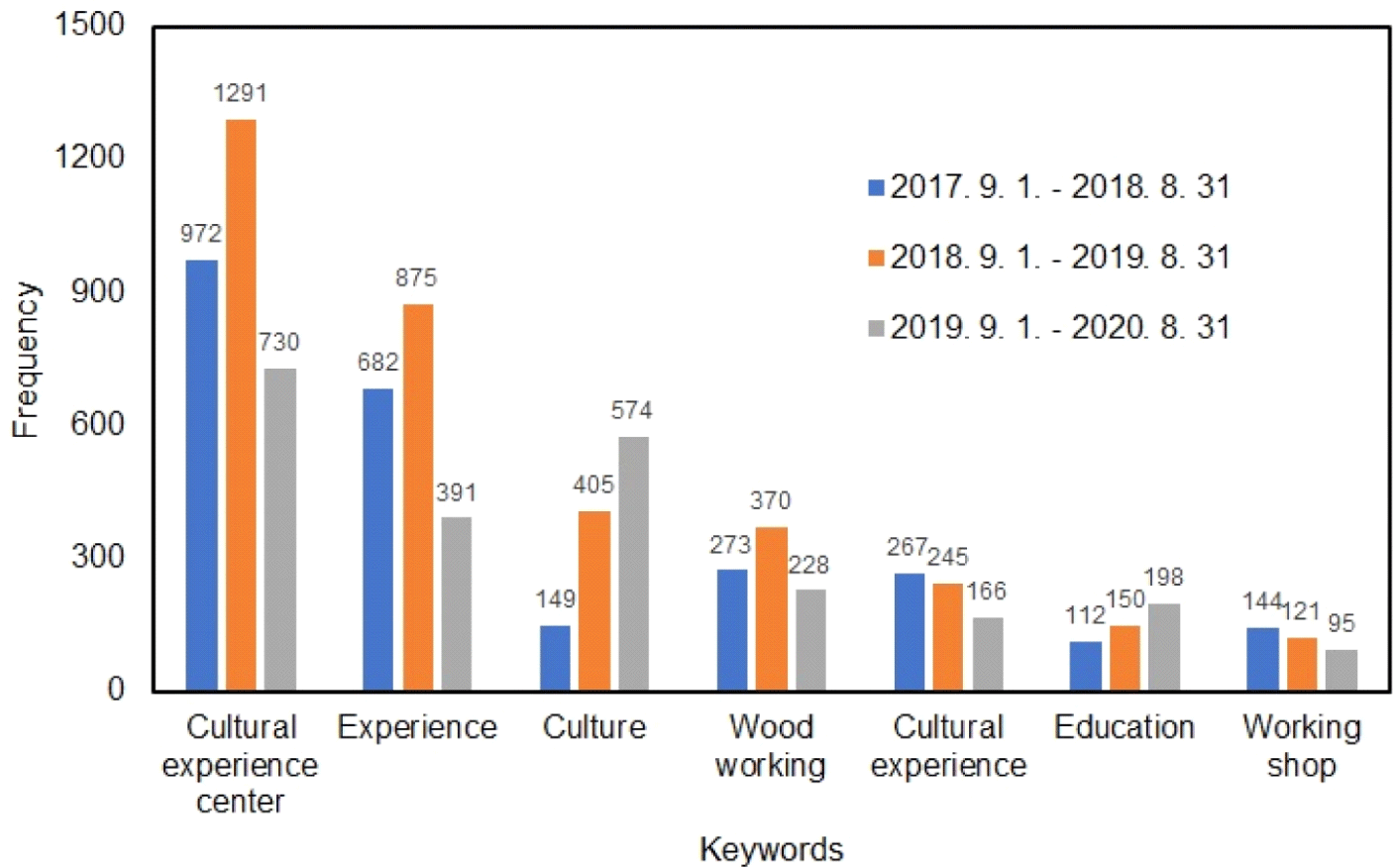
Similar groups were classified according to the correlations of keywords by applying the convergence of iteration correlation (CONCOR) analysis. The shape of the figure presented as a result of CONCOR was simplified as shown in Fig. 4 by removing the connecting lines because the connections according to the correlations were highly complex. Keywords derived as a result of entering wood as a search word through CONCOR analysis can be classified into five clusters: Wooden architecture, cultural education, woodworking, wood industry, and wood policy. The field that formed the largest cluster was wooden architecture, which could be divided into deck, construction, work, etc. related to the construction of country house on the one hand, and materials, installation, floor, etc. related to interior on the other. Because the clusters of cultural education and woodworking have many correlations and similarities, it was difficult to separate the two clusters. Various kinds of wooden furniture were included in both clusters at the same time. Various types of wood products such as plywood, paper, waste wood, and energy were presented for the cluster of the wood industry. Among them, energy formed a small cluster with pellets, pellet boilers, and fuel. Lastly, KFS, quality, domestic, import, illegal, and felling were included in the wood policy cluster. It appears that the legal timber distribution system was presented on the portal site along with the management and enforcement of the quality standards for wood products carried out by KFS.
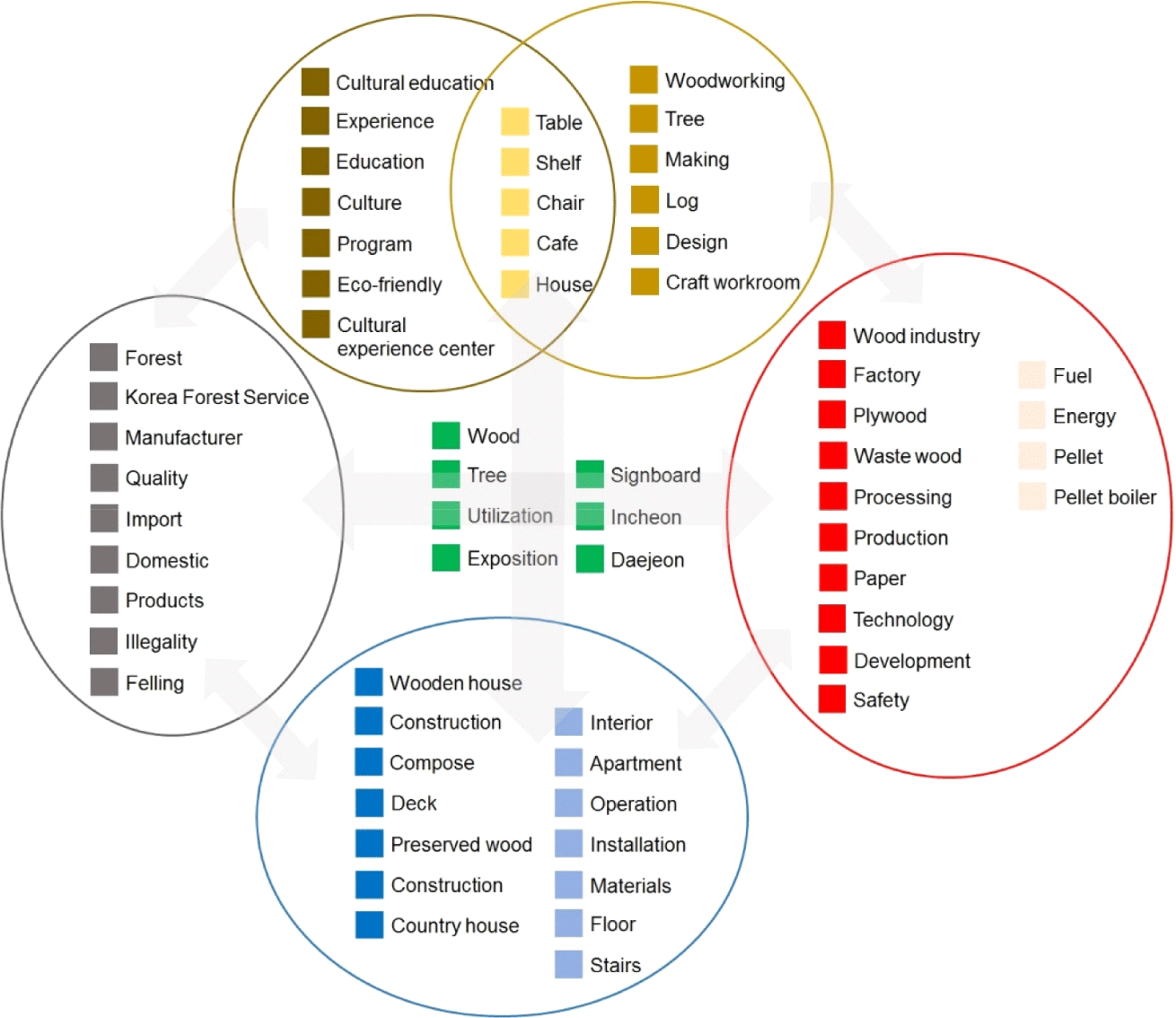
A survey about the general public’ perception of wood as a building material was performed. First, when asked what material was most often used in Korean traditional buildings, 78.8% of respondents answered wood [Fig. 5(a)], followed by soil (10.8%), reinforced concrete (8.7%), and stone (1.7%). Furthermore, the replies to the question concerning the most familiar material among the housing materials were wood (66.4%), reinforced concrete (18.0%), soil (13.5%), and stone (2.1%) in descending order [(Fig. 5(b)]. This result implies that the general public is more familiar with wood as a traditional building material in Korea.
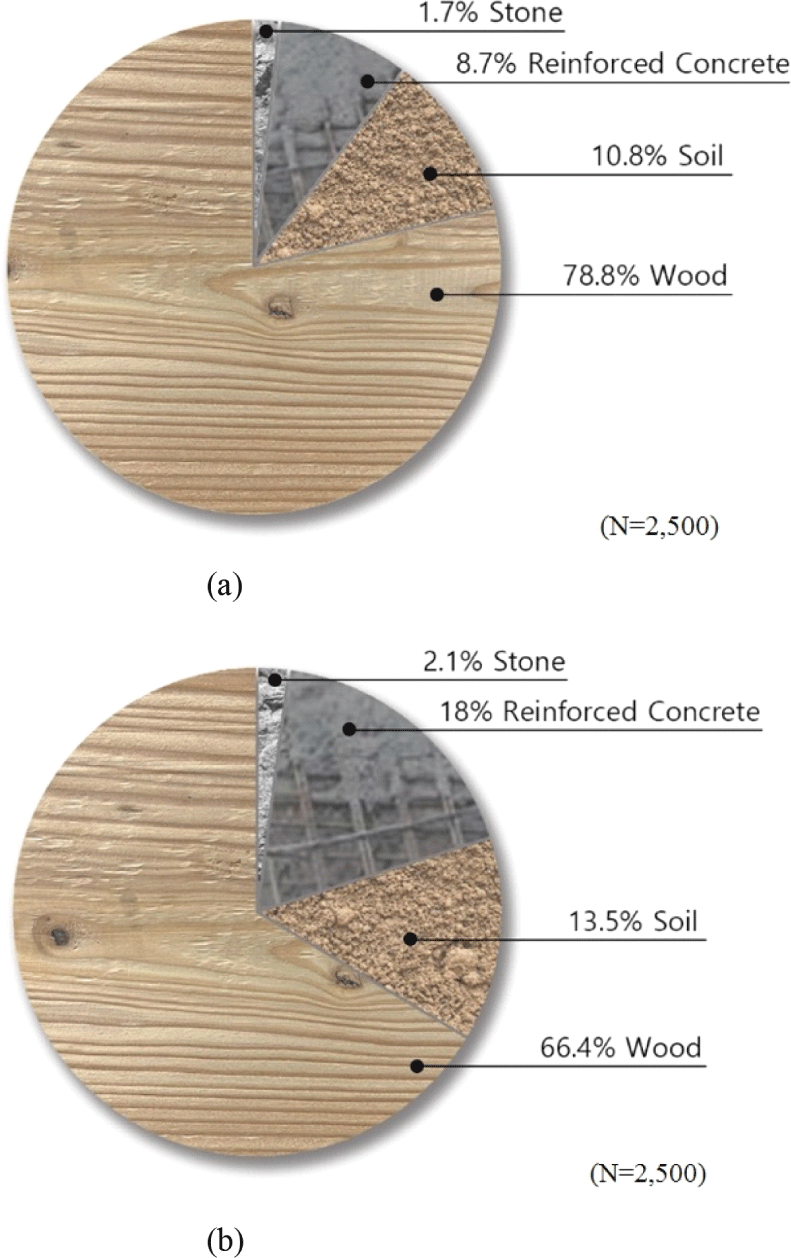
Among the types of houses in which respondents currently resided, apartment had the highest response rate at 68.0%, followed by villa/townhouse (11.0%), non-wood detached house (9.0%), multi-unit house (6.7%), and wooden detached house (4.6%; Fig. 6). As of 2020, the proportion of wooden (10,103 buildings) to residential and non-residential buildings (185,824 buildings) was 5.43%, and the proportion of wooden detached houses (7,924 buildings) to the total detached house (48,945 buildings) was 16.2%. In comparison to this, the occupancy rate of detached houses was relatively low among the respondents (Korean Statistical Information Service, 2022). When asked about the type of house the respondents would like to live in, “wooden and concrete mixed house” was the highest at 42.5%, followed by “wooden house” (31.3%) and “concrete and steel mixed house” (25.2%). The ratio of the general public who wanted to use wood as a building material for structures and interior/exterior was 73.8%, which was similar to the positive ratio of 79.3% for the opinion that wood utilization would increase in the future.

More specifically, to the question about the intention to use wood for house and interior construction, 51.1% of the respondents responded that they would use wood without considering the country of origin, and 35.5% wanted to use only domestic wood [Fig. 7(a)]. When using domestic wood, superior quality (70.6%) was considered as the most important condition, followed by low price (15.2%) and promotion of the domestic wood industry [10.0%; Fig. 7(b)]. To respond to environmental problems such as climate crisis, it is advantageous to use domestically produced materials as building materials with the longest service life. Therefore, it is necessary to publicize the fact that using wood as a building material is good as a response to environmental problems. Moreover, it is necessary to publicize that building materials are produced according to the “standards for wood products and quality standards” defined by the Act on the Sustainable Use of Timbers (KFS, 2013; National Institute of Forest Science, 2015).
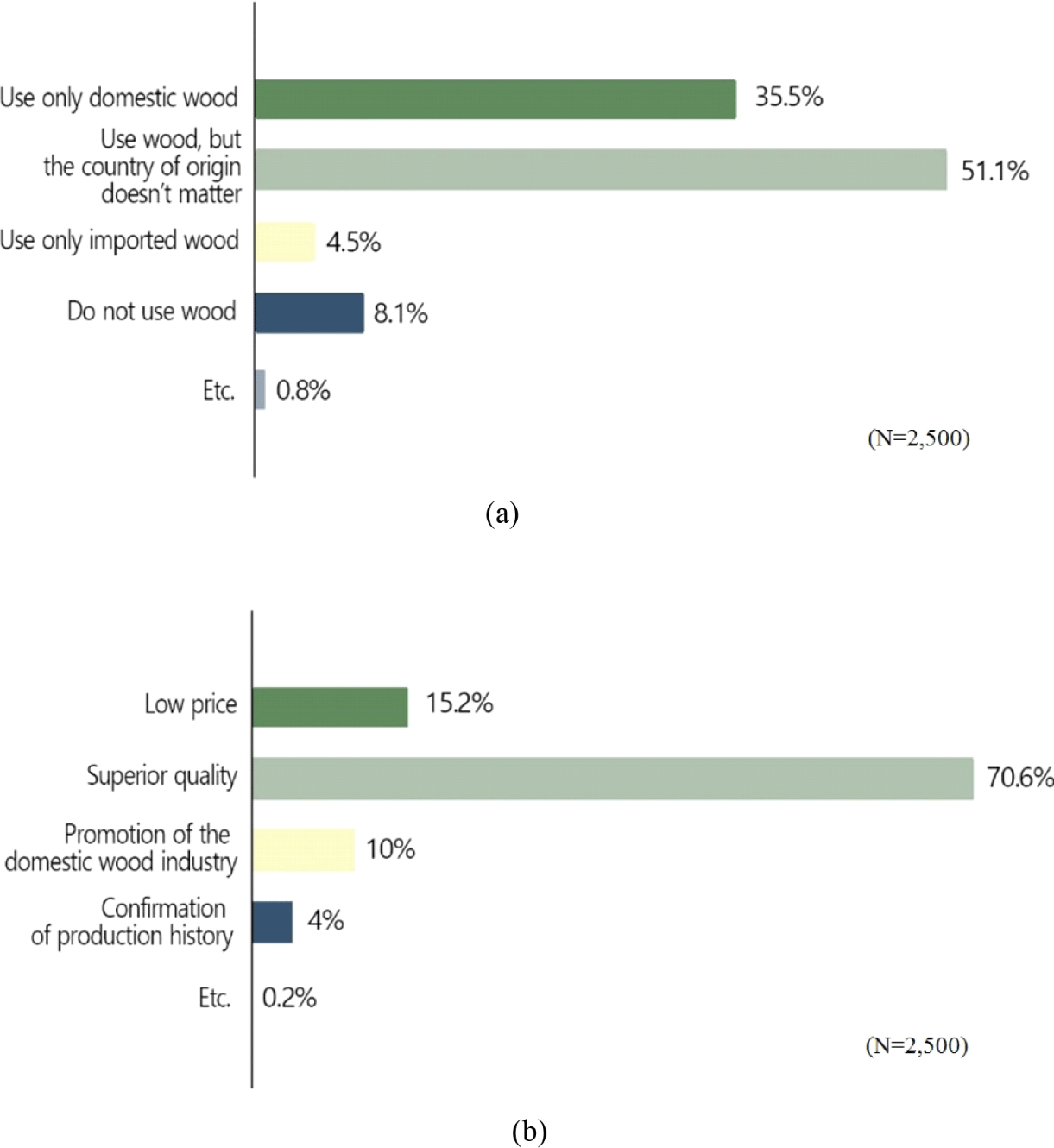
When asked about the degree of having wood products in their living space, 70.2% of the respondents answered that they had wood furniture and mainly possessed wood household items and wood ornaments (Fig. 8). When asked about the extent to which wood was used in major activity spaces excluding living spaces such as workplaces, schools, libraries, and cultural centers, 53.8% of the respondents answered that they did not use wood at all. Some respondents answered that structures such as floors, ceilings, columns, frames, and walls were composed of wood [Fig. 9(a)]. Wood products used in main activity spaces except living space were, in descending order, wooden furniture (58.4%), wood office equipment (39.8%), and wood auxiliary products for learning, exercise, and experience [26.1%; Fig. 9(b)]. The survey results showed that more than 70% of the respondents were using various items including wooden furniture, and that the wood utilization rate has been increasing recently in public facilities excluding living spaces.
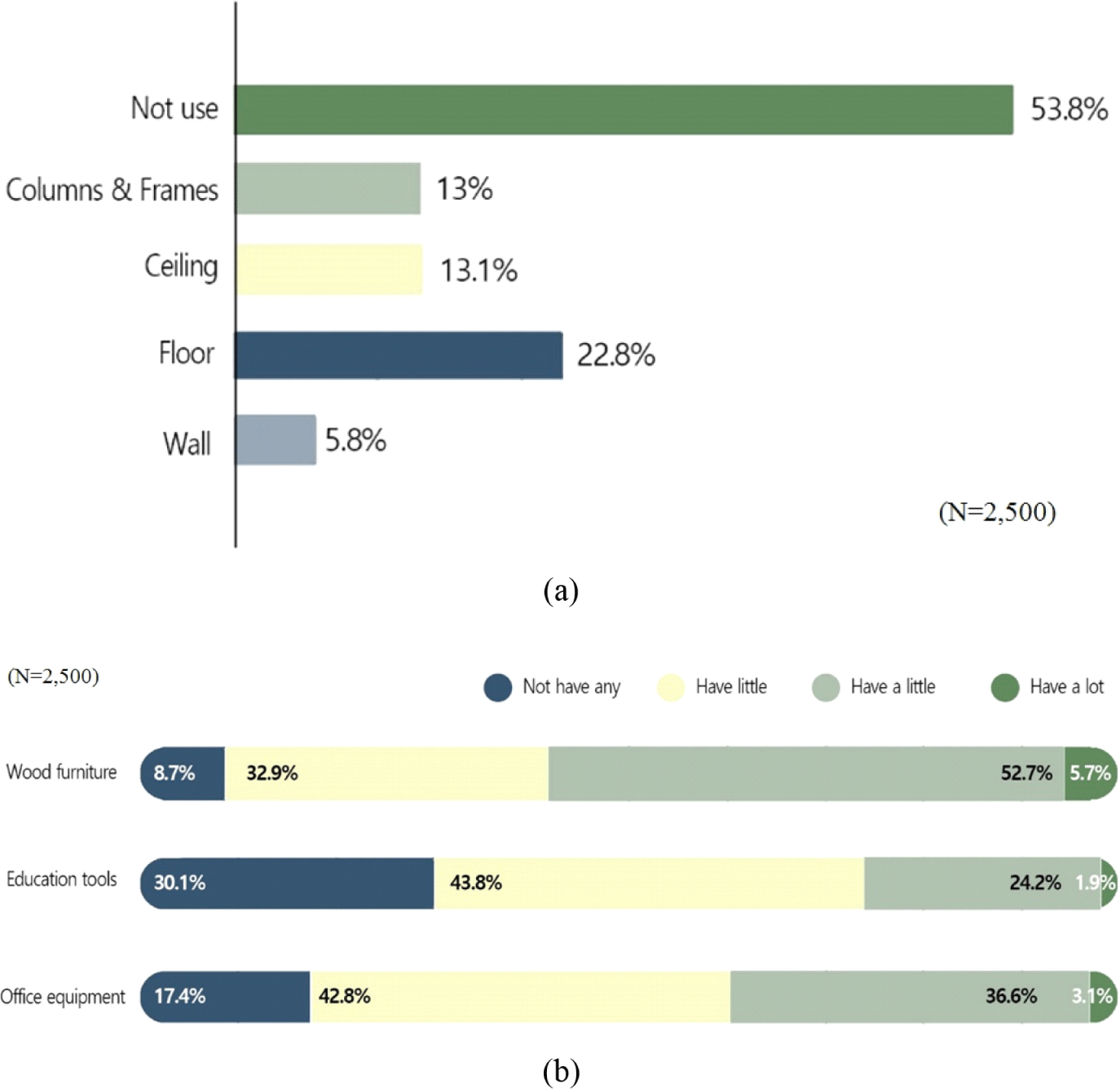
Among the questions about the health of residents of wooden houses, the positive rate was 65.0%, the negative rate was 8.4%, and the rate of respondents who answered “do not know” was 26.6% to the statement “the average life expectancy of people living in wooden houses is longer and the incidence of cancer is lower than those living in concrete houses”. Furthermore, to the statement “research found that forest bathing effect can be obtained when the interior of the room is made of wood”, the positive rate was 70.0%, the negative rate was 9.8%, and the ‘do not know’ rate was 20.2%.
Numerous domestic and international studies on the antioxidant efficacy of plant-extracted essential oils have been conducted (Lee et al., 2021). In particular, it has been reported that essential oils extracted from the leaves, xylems, and flowers of major domestic conifers such as Korean red pine, Japanese larch, Japanese cypress, and Korean pine have anti-inflammatory effects (Yang et al., 2019), antibacterial effects (Ham et al., 2020), and effects against skin diseases and lung diseases (Ahn et al., 2018, 2021). Furthermore, physiological indices such as pulse rate, blood pressure, autonomic nerve activity, and brain activity were evaluated when seeing, touching, or smelling wood to analyze the characteristics of wood that have beneficial effects on humans (Ikei et al., 2017). In studies on the effect of wood used in the interior of buildings, the autonomic stress response was reduced when wood was used (Burnard and Kutnar, 2015), and it was beneficial to the autonomic nervous system and respiratory system (Zhang et al., 2017). As a result of conducting a survey after living in an indoor space where wood was installed, the higher the amount of wood used, the higher the score for subjective comfort was (Tsunetsugu et al., 2007), and the decrease in insomnia improved the quality of sleep and induced comfort (Morita et al., 2020). Various research on the human body and environmental friendliness according to the use of wood like these has been recently conducted at home and abroad. Quantitative research results on human body and environmental friendliness can be a priority publicity method to improve the public’s awareness of wood. For this purpose, research for quantitative evaluation of human body and environmental friendliness according to changes in the residential environment when domestic wood is used as interior and exterior materials of buildings including quantitative evaluation of the human compatibility of specific components produced from domestic wood need to be actively carried out.
4. CONCLUSIONS
In this study, a survey was conducted on the trend of wood utilization and living environment of the general public with the aim of preparing a plan for increasing wood utilization and establishing wood culture. In addition, text mining was performed on the results of searching for “wood” on major domestic portal sites to derive the results of the general public’ interest in wood utilization. Through this, the following conclusions could be obtained.
(1) 79% of general respondents and all expert respondents agreed that wood utilization would expand to address climatic and environmental issues, as well as to obtain favorable health and emotional effects. However, some respondents predicted a drop in wood utilization owing to the high cost, difficulty of management, and deforestation caused by logging. Wooden furniture, wooden architecture, and interior/exterior materials, all of which are directly tied to everyday life, are examples of fields where wood utilization has recently been active.
(2) Excluding wood, the frequencies of wood, synthesis, goods, deck, and cultural experience center were high in rankings when the term “wood” was searched for on large domestic portal sites. The keywords could be grouped into five clusters using the CONCOR methodology of dividing them into comparable groups based on their correlations: Wooden architecture, cultural education, woodworking, wood industry, and wood policy.
(3) Wood was seen as a more traditional construction material with a friendlier image than reinforced concrete and stone. The intent to utilize wood for building and interior design was as high as 86.6%, and superior quality was emphasized in particular.
(4) When asked about the average lifespan and the prevalence of cancer diseases among wooden house residents, 65% of the respondents answered that wood had a positive effect on health. Quantitative analysis of friendliness to human body and environment is required to raise awareness of the eco-friendliness of wood utilization.


